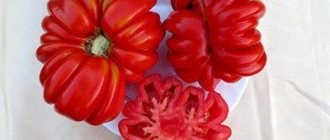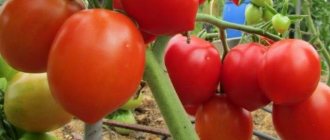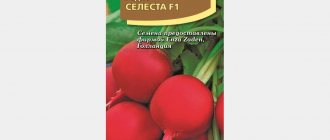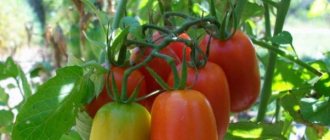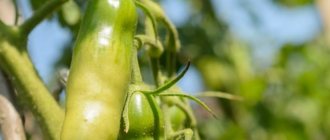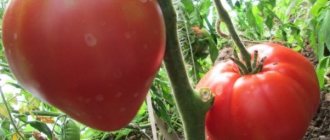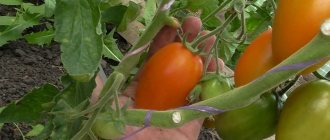Short description
Ampelous tomatoes in a hanging pot
Thanks to selection processes, classic tomatoes can have very large fruit sizes. The strength of the connection between the berry and the petiole is quite high, and thanks to the garter to the supports, there is no need for a thick trunk and branches of the tomato bush.
It would seem that everything in tomato culture is ideal - gardeners can shape the plants in any way they want and get rich harvests. However, this method of cultivation has one, at first glance, unnoticeable drawback: to grow tomatoes and get a good harvest, a lot of soil is required.
Indeed, placing a more or less large crown in a small area without “driving” it upward is quite problematic. In addition, even with its correct configuration, it will not be possible to deceive nature - the plant needs a certain base to receive nutrients, and the more fruits it produces, the larger its root system should be.
Ampelous tomatoes in a greenhouse
This means that if you limit the amount of soil, you cannot expect too large yields. Therefore, classic tomatoes are practically not grown at home - the crop needs a sufficient amount of soil, which is only available in the garden.
However, there are varieties of tomatoes that do not have this disadvantage. They can grow with the minimum amount of soil required for the root system, and the crown, in theory, may not require formation at all. These are ampelous tomatoes.
Of all vegetable crops, hanging tomatoes have one useful property: they allow almost any formation of their crown. In most cases, it is acceptable to do nothing with it at all.
To some extent, ampelous varieties are the complete opposite of standard varieties - sometimes it is even impossible to understand whether the plant has a central stem or not. But even with this approach, these crops can fully reveal themselves, both in terms of productivity and from a decorative point of view.
Traditionally they are grown in hanging pots, with their branches hanging down freely. The size of the fruits of ampelous tomatoes is relatively small, but their number can be impressive. And if we consider the ratio of yield to the amount of soil used, then hanging varieties can be significantly ahead of classic varieties.
Growing ampelous tomatoes in pots
In addition, hanging tomatoes have another interesting property: due to their appearance, their crown is very decorative, so these varieties are often used not only as a source of berries, but can also be used as garden decorations.
The cascading vines of the stems are decorative in themselves, but they look especially good when bright fruits of red, burgundy or orange shades appear on the branches. Often, a covering layer is formed from the crown of ampelous tomatoes, both in the vertical and horizontal planes.
Tomato variety Cherry Falls F1
Often manufacturers (Aelita, Semko, Siberian Garden, etc.) produce seeds of not just one variety, but several at once. The characteristics of the varieties included in the mixture are specially selected. Usually, they have the same fruiting time, but differ in appearance. The purchase of such mixtures will be most useful for those who grow hanging tomatoes for decorative purposes.
The article discusses the features of growing this crop, and also provides a brief description of the best varieties of hanging tomatoes.
Summer care
As tomatoes grow, they need pinching. If the plant is formed into one stem, then all stepsons must be removed. If there are two stems, then one stepson located under the first flower cluster does not need to be removed. The lower stepsons develop well and bloom profusely. A tomato bush with several stems remaining looks much prettier.
If during the flowering period the plant is indoors, then sometimes you need to shake the flower brush or the entire plant.
It is recommended to feed ampelous tomatoes to increase yield. Typically, gardeners use mineral fertilizer complexes. The dose of fertilizing is determined by the volume of the container where the seedlings are located. Plants are fed once every fourteen days, when watering. Watering is necessary during periods of drought, because potted plants do not have the opportunity to seek additional moisture in the ground. Remember that in flower pots the soil becomes dry much faster, so watering should be systematic, but without overwatering.
The best time to harvest is when the fruits are colored. But if you grow this variety of tomatoes just for the sake of beauty, then the colored tomatoes can be left on the branches.
If you are planning to plant tomatoes in your garden, but you don’t have enough free space, then you need hanging tomatoes. They can be grown even at home. These varieties will allow you to significantly save space and get the desired harvest.
Buckets, various containers or hanging pots are suitable for growing. Tomatoes can be grown at home right on the windowsill. Caring for them is quite simple and can be done even by a beginner in gardening.
In addition to juiciness, tomato fruits have the following advantages over other crops:
- Firstly, they can be planted much earlier than seedlings for a greenhouse or garden. This is all about caring for the plant.
- Secondly, you can enjoy the taste of tomatoes all year long if you grow them at home on your windowsill.
- Thirdly, ampel varieties of tomatoes are less likely to be infected with diseases, since the soil in which they grow is constantly ventilated and saturated with oxygen.
Popular varieties of ampel tomatoes
Traditionally, ampel tomatoes are classified according to their ripening time. Next, we will consider the currently most popular varieties, given from the description and characteristics.
Garden pearl
Garden pearl
Garden Pearl A mid-season variety with a ripening time of about 3 months. The height of the bush is approximately 40 cm. It is mainly used as a productive crop.
The fruits are pink and quite large. Their weight can reach up to 20 g. The shape of the fruit is round. The pulp is relatively hard, but at the same time very tasty.
The variety is unpretentious and does not require pinching. For normal cultivation, it needs a spacious container, the minimum volume is at least 3 liters.
Red abundance
Red abundance
Red Abundance It is a low-growing bush from 15 to 20 cm, forming branches up to 60 cm long. It is undemanding in care, easy to form: shaping the bush, removing side shoots, pinching and even tying the variety is not required.
An early-ripening representative of low-growing tomatoes, bearing fruit 50 days after planting. It is recommended to plant in February. The fruits are small, dense, up to 20 mm in diameter, red in color. The tassels can contain up to 30 berries.
Fruiting plants produce up to 2.5 kg of berries per bush. The berries are well suited for both fresh consumption and canning.
Rowan beads
Rowan beads
Rowan beads Mid-season variety with a growing period of 85 days. The clusters begin to bear fruit almost simultaneously. Determinate plant with climbing shoots up to 1 m.
The shoots can be tied to supports or let down if grown in a pot. The name “rowan beads” is due to its beautiful appearance and the large number of fruits in the clusters.
The fruits are miniature, in rare cases weighing more than 15 g. They have a bright red color and a sweetish taste. Can be stored for a relatively long time. Productivity up to 3 kg per bush.
golden bunch
golden bunch
Golden bunch Mid-season variety, growing time up to 80 days. Ideal for balcony growing or planting in hanging containers. The length of the shoots is 50-60 cm.
Prone to stepsoning. It has a low growth rate and is relatively difficult to care for.
The fruits are round, smooth, orange in color, weighing up to 35 g. Despite the low yield (about 1 kg per bush), it has an excellent sweet and sour taste and aroma.
city dweller
city dweller
Gorozhanin Hybrid Gorozhanin F1 is an early ripening variety. Ripening time is up to 2.5 months. The variety is classified as large-fruited. The berries weigh 35-50 g, round in shape, bright red in color.
The yield is high, up to 2 kg per bush. Intended for fresh consumption.
The plant is tall, the stems grow up to 80 cm. It requires timely removal of stepsons and requires container volumes of at least 5 liters.
Cascade
Cascade
Cascade There are several hybrids of this variety, the most popular of which are Cascade Red and Cascade Elo. Both are mid-season with a ripening period of 3.5 months. Hybrids have a tall bush (up to 1.5 m), the degree of branching is high.
The fruits are very large (up to 60 g), bright red in color with juicy pulp. It is considered high-yielding, up to 3 kg of berries per bush.
The advantage of the plant is its relatively simple care: despite the abundant, even overly thickened crown, it is not recommended to remove the stems. It is enough to cut off dried or yellowed leaves.
brindle
brindle
Tiger A very early variety, fruiting occurs within 1.5-2 months after planting. Recommended for growing in greenhouses or other film shelters.
It has a low height (no more than 25 cm), but due to the branching crown it reaches up to 50 cm in diameter. There are a lot of leaves on the branches and they are quite large.
The compact fruits of this low-growing variety have striped skin, hence its name.
Broody
Broody
Klusha Medium early determinate variety (ripening time up to 3 months). Low-growing bushes rarely reach a height above 45-50 cm. At the same time, the crown is densely leafy and spreading. No pinning required.
In fact, it is not an ampelous variety, since it has a standard stem. However, due to its compact size, as well as very dense brushes, characteristic of hanging forms, it is often classified in this group.
An interesting feature of the Klusha variety is the location of its fruits - fragrant tomatoes are hidden under the foliage in the depths of the bush. The fruits themselves are quite large (which is also not typical for ampels), weighing more than 80 g. The berries have universal use - they are eaten fresh, used for preparing first and second courses, or canned.
De Barao
De Barao
De Barao A variety that is also not classified as ampelous in terms of formal characteristics, but has a clustered fruit arrangement. It has a powerful stem that grows up to 2 m.
The variety is indeterminate and has immunity to late blight. It belongs to the late variety (4 months pass from sowing seeds to fruiting), mainly grown in greenhouses and hotbeds.
The fruits are oval in shape. Their weight is small - from 60 to 70 g. One cluster can contain more than a dozen fruits. The color depends on the specific variety: the berries can be red, black, pink or yellow. The pulp is fleshy, sweet with a slight sourness, very tasty.
The purpose of De Barao tomatoes is universal - they are used for preparing salads, first and second courses, and canned.
Yellow miracle
Yellow miracle
Yellow Miracle Late-ripening determinate variety with a growing period of 3.5 to 4 months. It bears fruit for a relatively long time. Height – up to 50 cm. The stem has high branching. When grown in the usual way, it requires a garter.
The yellow fruits weighing up to 35 g have an attractive appearance. They have round elastic skin. The taste is classic tomato with barely noticeable sourness. Productivity up to 3.5 kg per bush.
Cherry
Cherry
Cherry A classic ampelous variety, known to almost everyone. Among amateur gardeners it is considered one of the best in terms of cost-to-result ratio. It belongs to the mid-early variety, the fruits appear 2 months after planting.
Brought out as a result of many years of amateur selection, due to which it is distinguished by shade tolerance and disease resistance. Able to withstand short-term cold spells, not afraid of drafts and does not need shelter.
The height of the bush can reach 1 m. The fruits of the classic variety are bright yellow, weighing from 10 to 70 g, and have an excellent taste. There is also a variety with red fruits.
The only disadvantage is the uneven size of the fruit. On the other hand, it has a fantastic yield, reaching 4.5 kg per bush. The optimal scheme for planting plants is 60x60 cm, so that per 1 sq. m there were 4 bushes.
Mascot
Mascot
Talisman It is considered an ornamental variety, but with proper care it can produce good harvests. It is medium late, ripens approximately 3.5-4 months after planting.
A feature of the variety is its resistance to cold weather and, in general, unpretentiousness. The bush is relatively tall (up to 1.2 m), the degree of branching is average.
The fruits are reddish-orange in color and can weigh up to 80 g. It is believed that the fruits of this variety can be used immediately after picking, without going through the ripening phase. This has a certain justification, since the ripening of even fruits in one cluster does not occur simultaneously.
City dweller F1
There are two options for growing this variety: as a standard hanging plant or with a garter. In the second case, it will be a compact bush with erect shoots. It is important to know that City dweller F1 is quite large, so for normal development of the root system a container of at least 4 liters is needed. In order for the fruit to set as quickly as possible, the stepsons should be removed. If you continue to form the shoots, you can get a plant that will be covered with a huge number of large tomatoes of a juicy red color. They will delight you with their pleasant taste and bright appearance.
Related article:
How to grow large tomatoes
Features of cultivation of ampelous tomatoes
Ampelous tomatoes grown on the balcony
In terms of agricultural technology, hanging varieties are practically no different from ordinary tomatoes. Their cultivation is carried out using the classic seedling method, with the only difference being that adult seedlings are planted not in open ground, but in containers of limited volume. Here you need to understand that depending on the use of the crop, the approach to packaging will be slightly different, different from other vegetables (the same tomatoes, cucumbers, eggplants, etc.)
If an ampel tomato is used as an ornamental plant, the container volume may be small. Containers with such plants can be hung almost anywhere. Indoors, pots with plants are mainly placed near windows, outdoors - on terraces or near various arches and columns.
When growing ampelous tomatoes, the plant needs fertilizing. A small volume of soil can be compensated by abundant fertilizing, consisting mainly of nitrogen fertilizers.
This method of growing is not suitable for productive plants, since nitrogen-containing fertilizers alone cannot be used, and their quantity in a small volume of soil should be too large, that is, eating such varieties is, to put it mildly, undesirable.
Ampel tomatoes
If the goal is to obtain some significant harvest, the volume of soil should be at least 5-10 liters. Often plants are planted in a plastic bucket.
It is not advisable to hang larger pots. As a rule, they are placed either on elevations or simply placed on the floor. A suitable option for a hanging tomato would be a flowerpot or a plastic pot located on a stable, high leg.
Often, hanging varieties (both decorative and productive) are grown on a balcony or veranda. In this case, the crown is not simply let down vertically, but is forced to entwine the structure of the balcony.
Harvest and storage
It is customary to pick ampel tomatoes for eating when they are slightly unripe. The fruits are carefully picked from the bunches and placed in a dry, ventilated place until fully ripe. Some housewives deliberately do not pick ripe tomatoes, but leave them for decorative purposes. Tomatoes do not last long, so it is recommended to make preparations from them.
The most decorative type of vegetable is, perhaps, ampelous tomatoes, the cultivation of which can decorate a garden plot, balcony, terrace and delight with its fresh ripe fruits at any time. Caring for them is not difficult, and the result will exceed all expectations.
Growing ampelous tomatoes
Ampel tomatoes
The general approach to growing this crop is similar to regular tomatoes. Therefore, planting dates, preferred locations for adult plants, soil composition and other details will be very similar.
Below they are discussed in more detail.
Selecting a location
South windows are the optimal place for hanging tomatoes in an apartment
Ampelous tomatoes prefer sunny areas. If this is a productive crop, the container with it should be placed on the south side of buildings, south of fruit trees, near windows facing south, on southern balconies, window sills, etc. The use of northern walls or shaded areas is undesirable. If it is necessary to decorate these areas, it is better to use other crops - petunia, dichondra, verbena, etc.
The place where the hanging tomato will be located must be illuminated by the sun for at least 8 hours a day, otherwise even the growing season of the plant will be meager, and there will be no need to talk about the yield.
Primer used
Peat
Adult plants do not need any specific soil or substrate. Considering that agricultural technology involves abundant fertilizing, the composition of the soil can, in principle, be anything. Of course, this does not mean that very poor soils, such as sandstones, should be used.
The optimal composition of soil for hanging tomatoes will be as follows:
- turf land;
- peat;
- humus.
All components are taken in equal proportions.
Ornamental varieties can be grown in substrate for indoor flower crops, but this does not play a special role.
When creating a soil mixture, regardless of its composition, it is recommended to add wood ash to it. The amount of ash is 15-20 g per 1 kg of soil.
Features of containers
Containers for hanging tomatoes of productive varieties
The recommended minimum container volume for comfortable growing of hanging tomatoes is 5 liters. For a productive variety you will need twice as much.
Stagnation of moisture in pots is undesirable, so they must have a drainage hole. There is no need to lay a special drainage layer (pebbles or crushed stone) on the bottom, but for hanging pots you should take care of where excess moisture will drain.
Usually, a special design is used for this purpose, which allows you to adapt some small container to collect excess water. This could be a saucer, a small jar, etc. It will not be noticeable, since the crown of the plant will almost completely hide the pot.
Planting
It is recommended to grow ampelous tomato seedlings in individual containers
Depending on the chosen growing method, planting dates differ by several months. The seedlings of the crop that will be grown in the room are planted at the same time as ordinary tomatoes - in February. Crops grown outside are planted in March. In any case, seedlings are planted approximately 40-45 days before planting the plant in open ground.
Many gardeners ask the question: why is it necessary to grow seedlings for a crop that will grow indoors anyway? The answer to this is relatively simple: usually, seedlings are planted in a special, more nutritious soil, which will not be so useful for adult plants.
In addition, the seeds have a certain percentage of germination and it will be very unpleasant if the seeds planted in a stationary place do not germinate. Seedling cultivation allows you to be guaranteed to obtain seedlings for planting in a permanent place. Of course, you can replant the plant at any time, but it is better not to do this, so as not to further injure the roots of young plants.
Seedlings can be planted immediately in separate containers, or you can first use a common container. Before sowing seeds, they must be treated with a 0.3% solution of potassium permanganate. Planting into individual containers (and sometimes directly into a stationary pot) is done when the seedlings have two true leaves. Usually, this happens 10-15 days after germination.
Tomato seedlings
When planting in individual containers, place 2-3 seeds in one hole.
Caring for seedlings is standard - daily watering, and 10-12 hours of daylight per day. The seedlings are regularly ventilated. Feeding is carried out twice during cultivation. They are usually done at 3 and 5 weeks. It is recommended to use nitrogen and potassium mineral fertilizers in dosages appropriate to the seedlings.
Transplantation to a permanent place
Decorative pots and baskets can be used as containers for hanging tomatoes.
As mentioned earlier, the optimal time for planting in a stationary container occurs approximately 1.5 months after planting the seeds. Canned tomatoes grown in open ground do not require hardening.
The main requirement when planting most of these varieties is to replant the whole plant with a clod of earth. In this case, the soil level in a stationary container must be at least 3 cm higher, that is, the lump of earth must be “sprinkled” with an additional layer of soil.
The convenience of compact forms makes it possible to perfectly protect them from frost in the simplest way - by bringing containers with plants directly into the living room during dangerous cold snaps. While return frosts are still possible, this will not pose a problem due to the small crown of the tomatoes.
What experienced gardeners say: reviews of hanging tomatoes
What amateur gardeners say:
Irina S., 52, Saratov: “This is not the first year I’ve been planting ampels at the dacha. Really like. It's a hassle, but it's worth it. The balcony has been refurbished for this season. They bloom beautifully, there are many inflorescences. I’m waiting for the first decorative Cherries.”
Sergey K., 49 years old, Sergiev Posad: “I tried to grow ordinary bush tomatoes as ampels, but there was no success. “Yellow Tom” lampshades have been growing on the veranda for two years. In terms of yield, it was expected, but the taste was disappointing. But for salting and marinating - that’s it!”
If you purchase plant seeds in special stores, and not online or in person, the chances of success are high. Otherwise, you may fall for fakes.
Caring for ampelous tomatoes
Growing ampelous tomatoes
The procedures for caring for ampelous tomatoes repeat similar procedures for conventional varieties. They include watering, fertilizing, loosening the soil, etc.
A feature of growing indoor varieties is the presence of additional lighting (if necessary) as well as artificial pollination.
Watering
Watering both seedlings and adult plants is carried out with a thin stream of water.
Watering is done as needed. Typically, the criterion for when it is time to water is the dry top layer of soil. It is better to water the plants with a small amount of liquid to avoid excessive moisture in the root system, which leads to the appearance of fungi.
Watering is done in the evening. For them, settled water is used with a temperature 2-3°C higher than the air temperature.
The leaves and stems of indoor plants are not sprayed and no sprinkling is done.
Approximately 60-90 minutes after watering, it is necessary to loosen the top layer of soil to a depth of about 3 cm. In hot weather, do not increase the watering rates, but reduce the time between them.
Feeding
Double superphosphate
Feed ampelous tomatoes once every two weeks. For this purpose, it is best to use a complex mineral fertilizer for ornamental plants. The application rate depends on the volume of the container. It is recommended to use 5 g of mixture per 1 kg of soil.
Fertilizing is done during watering, and the mixture is dissolved in water. In dry form, fertilizing is not applied.
Sometimes, instead of a specialized fertilizer, ordinary superphosphate is used. It is suitable in its pure form for feeding seedlings (1 tablespoon per liter of water is enough to fertilize 40 bushes).
During planting, 15 g of the substance is placed in a permanent place in the hole. But to fertilize adult plants, superphosphate should be combined with other fertilizers (potassium salt, Foxamide or Effecton mixtures, mullein, etc.)
Bush formation
Stand in the garden for growing overhead tomatoes
Despite the fact that hanging tomatoes are predominantly low-growing plants, they, like regular tomatoes, are divided into determinate and indeterminate varieties. Accordingly, each of them applies its own methods for forming the crown of a plant. For hanging tomatoes, the pinching procedure is also used.
Experience in growing tomatoes recommends the following method of forming the crown of bushes: indeterminate varieties - for two stems, determinate varieties - for two or three stems.
Features of caring for indoor varieties
Artificial pollination of tomato flowers
Plants grown indoors need 10-12 hours of light per day. In order to extend daylight hours, sodium or LED lamps are used.
These varieties also require artificial pollination. It is carried out using a soft brush, transferring pollen from the stamens to the pistils. Typically, the flowering of ampelous tomatoes is slightly longer than that of ordinary ones, but in any case it is recommended to carry out the pollination procedure 1-2 days after the inflorescences bloom.
It will be possible to check whether the ovaries have formed approximately a week after the end of flowering. If there are no ovaries, the brushes should be removed.
Harvesting
Harvesting of ampelous tomatoes is often done with whole clusters
The harvest of ampelous tomatoes is carried out at the stage of technical ripening, without waiting for complete ripening. At the same time, the fruits acquire a greenish-red hue, that is, in fact, green tomatoes are still collected from the plants. Often, they do not use individual picking, but rather pick several berries along with a bunch.
This is followed by the ripening phase, which occurs in a dry and warm place. Ornamental varieties are not harvested. The fruits, which additionally give the plant an attractive appearance, are simply left on the branches. They can be used for food, but the taste of such fruits will be worse than those that were collected in advance and went through the ripening procedure.
Recommendations for shaping different tomatoes
The bushes are formed not at their own discretion, but taking into account the characteristics of the varieties planted in the garden bed and their basic parameters.
To get strong and well-bearing plants, you must follow all the recommendations and focus on the correct procedure for forming tomatoes:
determinate varieties, they are characterized by a low placement of the first inflorescence, and it is important to move the growth point to a side shoot to strengthen the plant; indeterminate varieties require regular pinching, leaving several leaves above each raceme and one inflorescence on the stepson; superdeterminate varieties have a weak growth rate and it is important to pinch them before the last third or fourth inflorescence appears, limiting the growth of the bush.
Taking into account the biological characteristics, it is possible to correctly form the bush and ensure its further growth and excellent fruiting while maintaining a high level of productivity.
Diseases and pests of ampelous tomatoes
Manifestations of late blight
Ampel varieties of tomatoes, just like regular types, are susceptible to various diseases (fungal and viral), as well as pest invasions. The main cause of fungal diseases is excessive humidity when growing plants.
Next, the most characteristic diseases and pests of hanging tomatoes will be considered.
Blackleg
Seedlings affected by blackleg
Symptoms of the disease are the appearance of rot on the roots of young seedlings. The reason is too much moisture in the plantings. There is no treatment; affected plants should be removed along with a clod of earth.
For preventive purposes, it is recommended to treat the soil with Trichoderma before planting seeds, as well as moderate watering.
Late blight
Late blight of ampelous tomatoes
The cause of the disease is late blight - fungi from the class Oomycetes. It manifests itself in the appearance of dark areas on the leaves or fruits of tomato bushes. The disease can attack plants at any time of the year - both at the seedling stage and during harvest.
There is no treatment. To avoid spreading the disease to neighboring crops, the diseased plant should be completely dug up and destroyed (burned).
If the disease affects the crop in a state close to technical ripeness, you should cut off the entire bunch of tomatoes and place it in hot water for 1 minute, and then send it for ripening.
Gray rot
Early stage of gray rot
Mostly appears in the second half of summer. It affects the stems, leaves and fruits of the plant.
Plaque on the stems can exist for a long time without overly inhibiting the vital functions of the plant. But if the fruits are damaged, they quickly become unusable.
There is no treatment; affected plants are destroyed along with the harvest. A good way to prevent the disease is to periodically treat plants with Bordeaux mixture or sulfur preparations.
Mosaic of tomatoes
Damage to leaves by tobacco mosaic
A viral disease that first affects the foliage, then the stems and fruits. The causative agent is the tobacco mosaic virus, which attacks almost all Solanaceae. Initially, the disease manifests itself in the form of the appearance of individual yellow areas, then curling and deformation of the leaves is observed in the affected areas.
There is no treatment, but if the affected areas are removed from the plant at an early stage, its death can be avoided. The source of the disease can be anything: the virus can be carried by insects (very often this is done by aphids or ants), it can get onto plants from contaminated equipment, etc.
Recently, many seed producers have begun to carry out antiviral treatment. It is advisable to purchase just such planting material.
Insect infestation
The Colorado potato beetle is the main pest of nightshade crops.
Of all the pests, hanging tomatoes are most often affected by the following types of insects:
- spider mite;
- Colorado potato beetle;
- whitefly;
- aphids.
Depending on the type of insect, the appropriate insecticide is used. There are also universal products that have a wide range of applications: Aktara, Atkllik, Karbofos, etc.
Often, to repel insects, a container with garlic or another plant that has a characteristic odor is placed next to the container in which the tomatoes are located.
Landing rules
Planting hanging tomatoes at home begins in March. The material is placed to a depth of 3 cm. Before planting, they are soaked for 20 minutes in a low concentration solution of potassium permanganate, and then washed with water.
Ampelous tomatoes are planted in one of the following ways:
- in a regular pot;
- in hanging containers;
- "upside down"
To grow tomatoes, select a container with a capacity of 4 liters. You can place ordinary containers on a windowsill or hang them on a balcony or loggia. Suspended structures take up less space.
You can first plant the plants in small containers. When the seedlings sprout and grow stronger, they are transferred to a permanent place. The procedure is carried out in May. Tomatoes are replanted together with a clod of earth so as not to damage the root system.
The original way to grow tomatoes in pots is to plant them upside down. To do this, holes with a diameter of up to 10 cm are made in the container through which the plant stem passes. The tomato root system remains in the container.
This technology increases the yield of tomatoes, since the shoots experience less stress and are better ventilated. The free top part of the pots can be used to grow herbs, lettuce or other plants at home.
Cherry tomatoes
General information
Tomatoes have recently become increasingly popular all over the world. Small tomatoes are especially in demand in the Mediterranean; it is very difficult to find a dish here that does not include cherry tomatoes among the ingredients.
Cherry tomatoes are a garden variety of tomatoes with fruits of 10 - 30 g. They are known to everyone as a snack, which is used for preparing a variety of salads, as well as for preservation. There are certain varieties of cherry tomatoes that are dried. The name comes from the English word cherry, which means cherry. This does not mean that tomato and cherry have a similar taste. It’s just that the appearance and size of the vegetable is very similar to a cherry.
Small varieties are grown, just like regular ones. They grow remarkably well both in open ground and in greenhouse conditions.
On the shelves, bunches of cherry tomatoes look like toys, but this is a visual illusion. The taste of this small vegetable can add a new taste to even the most ordinary dish.
Despite its small size, this variety is quite tall. One brush can reach several meters in length. Most often it reaches one meter and about 20 fruits are formed on it.
Cherry tomatoes can be of the following shapes: elongated, teardrop-shaped, round.
These tiny tomatoes have a fairly diverse color palette: green, red, yellow, orange, pink.
Those who love to eat fresh vegetables grow them not only in garden beds, but also on window sills.
Such a tall plant really needs support. You can use long sticks. To make the cherry tomatoes look more presentable, you can use a hanging pot. It turns out to be a charming picture. Imagine for yourself: rich and rather long clusters and small, cherry-like tomatoes hang from the chest. These “beads” seem to be strung on openwork foliage. If you are going to grow tomatoes at home, then it is better to use varieties whose bush shape should be small and the height should not exceed 40 centimeters.
It is important to maintain soil moisture to prevent the fruits from cracking. It is necessary to harvest the crops in a timely manner, because if they are picked ahead of time, they will not be sweet enough, and an overripe vegetable will simply fall off
The taste of these little tomatoes is impressive; no one can remain indifferent. In nature, there is a cherry variety that is distinguished by its taste, which contains notes of melon, raspberries and blueberries. The name of these delicious tomatoes is “Winter Cherry”.
Varieties for open ground:
- Busiki is a fairly productive variety. The fruits are very sweet, and they are only 1 centimeter in diameter.
- Honey drop – the fruits are pear-shaped and have a beautiful yellow color.
- White currant - the fruit is creamy in color, round and very tasty.
- Black cherry is a very rare variety. Sometimes it is confused with a fruit.
- Cherry variety – the fruit color is dark red and the fruits are round in shape.
- Red/yellow cherry – early variety. It is grown in greenhouses.
Cherries grown on balconies:
- Balcony miracle is a fairly compact bush.
- Lisa - elongated fruits of yellow-orange color.
- Minibel is a very unpretentious variety.
- Lycopa – these fruits have a thin skin. They are plum-shaped and dark red in color.
- Mio is a smaller copy of a regular tomato.
- Kira is a fruit-like variety.
Ideal for hanging baskets:
- Cherry fingers - this variety does not require pinching. Its fruits are elongated with very juicy pulp.
- Garden pearl is a low-growing species that does not require pinching.
- City dweller is a fairly powerful variety that has little branching.
How to choose
When purchasing cherry tomatoes, special attention should be paid to the smell. Mature fragrances have a very pleasant and juicy aroma
If the tomato does not smell at all, it means that it was picked while still green, and they have not yet had time to ripen. When the stalk is broken and its color is unnatural, this is a clear sign that they have already ripened after being picked. When tomatoes ripen in this way, they lose all their beneficial properties. You need to choose medium-sized tomatoes without any damage.
How to store
One way to store cherry tomatoes is freezing. This option is suitable if you intend to keep them fresh, but the tomatoes can also be dried or felted. But the most common method is preservation.
For open ground
Low-growing varieties of yellow tomatoes are ideal for beds without film coverings. They do not need pinching or tying, so they require minimal care.
The most common representatives for the garden:
- Grapefruit. It will take 130 days to mature. The fruits are large, the bush gives a generous harvest.
- Duckling. Early ripening variety, resistant to diseases. Productivity is low - only 2.5 kg per square meter.
- Golden Queen. It is considered one of the best early ripening varieties for garden beds. The culture tolerates weather changes well. Harvest from 1 m2 10 kg.
- Dina. Mid-early representative of yellow tomatoes. The yield is average (4-5 kg per bush). Seeds can be collected by hand.
- Elephant eggs. High-yielding variety, bred in Australia. Ripening time – 120 days.
- Golden Queen. It has large fruits, weighing up to 700 g. Fleshy and tasty, universal in use.
Yellow tomato varieties are characterized by increased resistance to diseases and good adaptation to weather changes.
Cascade Elo F1
Another tomato variety grown in the same way as hanging flowers. Its shoots fall down to half a meter. There is no need to tie up the branches, as they will still bend under the weight of the bunches.
This variety will appeal to those who like tomatoes of non-standard colors, since this variety is light yellow. It blooms actively several times a season, and there is no need to plant it, which makes care very easy. The only important note: for good development of the ground part, you need a container with a volume of 5-8 liters.
Related article:
An economical way to grow tomato seedlings
Dwarf tomatoes, or superdeterminants
The shortest varieties of tomatoes are varieties and hybrids - “dwarfs”, with a bush height of up to 40 cm. They are usually grown on window sills and balconies, in small containers. But you can plant these “babies” both in open ground and in a greenhouse.
The main positive qualities of dwarf tomatoes are the resistance of seedlings to overgrowth, early ripening, extended fruiting period, fruits of equal size, also suitable for canning.
There is no need for pinching - their bushes grow dense and compact - another plus. Standard varieties have resistance to lodging, so they do not need to be tied up, unless to support a very abundant harvest. They have good immunity to major tomato diseases and adverse weather conditions.
The disadvantages of superdeterminants include low yield compared to larger varieties, and a limited choice of flavors - they all have the usual tomato taste, sometimes a little sweeter, sometimes a little sour.
Varieties and hybrids of dwarf tomatoes: “Balcony Red F1”, “Balcony Elo F1”, “Bonsai”, “Venus”, “Linda”, “Balcony Miracle”, “Balcony Miracle Yellow”, “Red Pearl”, “Snegirek” , “Baby Cherry Red F1”, “Pot Red”, “Grotto”, “Pepper Sturdy” and many others.
Tomato "Venus". ostaTomato "Linda". ucozTomato “Balcony Elo F1”. uasemena
Description of the yellow cherry tomato variety, features of cultivation and care
Cherry tomatoes are a group of vegetables that includes varieties and hybrids that have miniature fruits. The weight of cherry tomatoes does not exceed 30 g. At the moment, there are more than 100 types of small-fruited tomatoes. It seems that it may be different for varieties related to cherry. It turns out that they differ in shape, color and other characteristics.
Color and shape
Everyone is used to seeing only red fruits. But there are cherry tomatoes that have raspberry, yellow, green, black and orange colors. Ripe tomatoes have oval, round, teardrop-shaped and elongated shapes. The world saw the first fruits and a description of the variety back in 1973.
Israeli scientists presented the first development. They wanted to develop a crop variety that would slowly ripen fruits in hot climates. The name of the vegetables comes from the English word cherry, which means “cherry” in Russian. And this is no coincidence, since tomatoes look like the fruits of this tree.
Characteristic
By studying the characteristics of modern cherry tomatoes, you can understand that they are hybrids. They are resistant to sudden temperature changes regardless of the time of day. They develop in countries with hot climates. They are not afraid of moisture deficiency.
Depending on the length of the stems, they are divided into three types:
- determinant - short stature;
- semi-determinant - average height;
- indeterminate - tall.
Yellow cherry tomato, like other varieties with different colors, forms 3–5 clusters, on which 15 to 20 tomatoes ripen. Ripening of tomatoes on one bunch occurs simultaneously. That is why you can often see tomatoes at the market sold by sellers that are cut from a branch and not collected individually. These branches are used to decorate dishes, which looks very advantageous.
Taste and cultivation
Tomato varieties have early, medium and late ripening periods. 7% of all species retained extended periods of fruit ripening. Therefore, the first harvest is harvested in mid-July. Early and mid-season varieties can be found, but this is problematic.
Cherry cultivation is possible in open and closed ground conditions. Ampelous varieties are very successful. Specially bred for development on balconies. There are also tomatoes that are suitable for growing on windowsills.
Cherryki have incredible taste. Most of the market offers vegetables with a bright, characteristic tomato taste. If you look, you can find unusual varieties. The taste has rich melon, blueberry and raspberry notes.
The best varieties
Most often you can find seeds on sale that belong to one of the varieties:
Red, Ira and Fingers. Strawberry, Sweet Cherry and Yellow Cherry. Dr. Green Frosted, Ocean and Elf. White Muscat, Green Grapes and Cherry Blossom f Margol and Yellow Dates.
Thanks to the wide range, everyone can choose the right variety for themselves. At the same time, the color and size of the brushes are taken into account, especially for growing on window sills or balconies.
Advantages and disadvantages
Among the advantages are the following:
- the ability to choose the time of fruit ripening;
- high productivity;
- various flavors;
- Canning by the piece or by the brush.
Among the disadvantages, there is only one - susceptibility to certain diseases. Each variety has its own type of pest.
Use in cooking
Varietal cherry tomatoes are added to many dishes - snacks, sandwiches and salads. The smallest ones are suitable for decorating dishes that have undergone heat treatment. Tomatoes not only reveal themselves in salads, but also diversify assorted vegetables for the winter. Tomatoes perfectly fill the free space in the jar and look beautiful.
More advanced housewives dry or dry cherry tomatoes. This also allows them to be used for cooking. In its whole form, it is added to vegetable pies, sauces and side dishes are prepared. Gardeners will definitely like cherry tomatoes.
